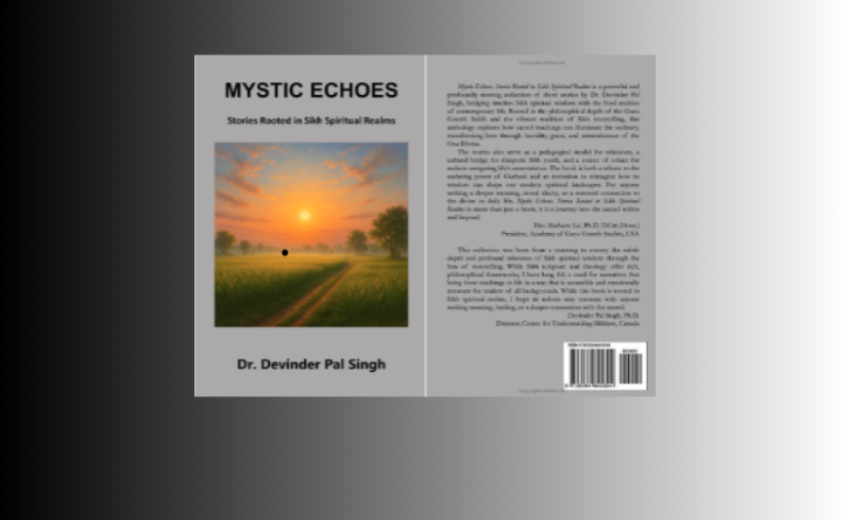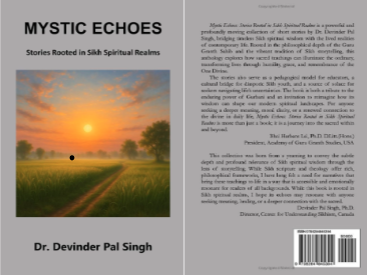Book Review by
Prof. Hardev Singh Virk
SGGS World University, Fatehgarh Sahib (Pb.)
Book Name: MYSTIC ECHOES: Stories Rooted in Sikh Spiritual Realms
Author: Dr. Devinder Pal Singh, Toronto
ISBN-13: 9798284845394
Published: First Edition 2025
Price: US$9.99 (Paperback), Pages: 213
Publisher: Center for Understanding Sikhism, ON, Canada
Dr. Devinder Pal (DP) Singh joined the Physics Department in 1983 as an Ad-hoc Lecturer to teach Physics and complete his doctorate degree in Physics (Acoustics). I found him as a dedicated teacher and researcher. Upon moving to Canada as an immigrant, he initiated a new venture, the “Center for Understanding Sikhism”. A similar organization, the “Institute for Understanding Sikhism,” was established earlier by Dr. D. S. Chahal in Montreal. I was perplexed as to why a hardcore physicist was meddling in Sikhism. My curiosity was satisfied after reviewing his book, “Science and Sikhism: Conflict or Coherence.” I started rating him as one of the greatest exponents of Sikhism (Sikhi) in the modern age.
The Foreword “A Sacred Mirror: Seeing Ourselves Through Sikh Narratives” has been written by Bhai Harbans Lal, Ph.D., D. Litt (Hons). I used this Foreword as my launching pad to understand the contents of “Mystic Echoes”. Bhai Lal appreciates the technique used by D. P. Singh: “It brings the living essence of Gurbani into our day-to-day existence. These are not abstract theological exercises, nor are they simply nostalgic tales of rural life. Instead, they are powerful spiritual parables, immersive narratives that reveal how the universal truths embedded in Sikh teachings manifest in the hearts, struggles, and transformations of everyday people”.
The author introduces his UNIQUE work in the Preface “Bridging the Temporal and the Timeless” as follows: “The stories in Mystic Echoes: Stories Rooted in Sikh Spiritual Realms emerge from the convergence of profound spiritual reflection, lived experience, and the enduring resonance of Sikh philosophy. They are not merely works of fiction, but narrative expressions of spiritual truths rooted in the teachings of the Sikh Gurus”. Further, D. P. Singh explains the relevance and importance of chosen topics: “Each story in Mystic Echoes is an attempt to explore a specific spiritual theme from within the Sikh tradition: Naam (Divine Name), Hukam (Divine Order), Haumai (Ego), Maya (Worldly Illusion), Raza (Divine Will), Sunn (Primal Void), Sahaj (Equilibrium), Bhaau and Bhae (Devotional Love and Reverent Fear), Nadar (Grace), Wismad (Wondrous Bliss), Anhad Naad (Unstruck Melody), Chautha Pad (Fourth State), Dasam Duar (Tenth Gate), Panj Tat (Five classical elements), and Daya (Compassion) among others.
I would like to summarize the key points of 20 Chapters in a few paragraphs, rather than discussing the contents of each Chapter. In Chapter 2, “Echoes of Naam”, Manpreet asks his grandpa, "Babaji, why do you waste your time with all these rituals?" The answer given by his grandpa, on page 23, did not clarify his doubts: "Words are never just words, beta," Harnam replied, opening his eyes. "When your mother scolded you as a child, did those words not sting? When your teacher praised your work, did those words not lift your spirit? Words carry power, and the divine Name, Naam, carries the greatest power of all." Ultimately, grandpa gives his final opinion about Naam based on his personal experience: "Perhaps what you need is not an explanation," Harnam said thoughtfully, "but an experience."
In all Chapters, the author has employed this technique to convey the essence of Gurbani concepts. I used to listen to some prominent exegetes (kathakars) of Gurbani, including Sant Singh Maskeen. They all use parables/stories to explain the meanings of Shabdas. D. P. Singh has perfected this technique by introducing parables to teach Gurbani concepts to the new generation, who are not frequent visitors to Sikh shrines called gurdwaras. In my view, this technique will be useful only if the younger generation is familiar with Gurbani; otherwise, the parables will be devoid of meaning as a narrative.
In Chapter 6, the author beautifully explains “Bhaau and Bhae: the subtle difference”. He wants to teach a lesson using a parable regarding the 'New Light Khalsa'. “They study Sikh philosophy but with modern interpretations. They believe some of our traditions are outdated and need revision to be relevant today." The arguments of Giani Ravinder Singh, supporter of 'New Light Khalsa', represent the approach of new generation: “Ravinder spoke of bhaau (divine love) as the only necessary element of Sikh spirituality, dismissing bhae (divine fear) as a concept misunderstood and corrupted by traditional interpretations. "The 5 Ks are symbolic, not literal requirements", Ravinder asserted confidently. "The Gurus intended them as metaphors for spiritual qualities, not physical tokens." The author elaborates these concepts using a dialogue between grandpa Harjit and his grandson, Gurpreet to convince him. At the end of discussion, Gurpreet concludes: "I realized that understanding bhae (divine awe), actually deepens bhaau (divine love). They're not opposing forces but complementary ones."
The author tries to establish his technique of using parables to explain other important concepts of Gurbani, for example, Hukam (Divine Order), Haumai (Ego), Maya (Worldly Illusion), Raza (Divine Will), Sunn (Primal Void), Sahaj (Equilibrium), Nadar (Grace), Wismad (Wondrous Bliss), Anhad Naad (Unstruck Melody), Chautha Pad (Fourth State), Dasam Duar (Tenth Gate), Panj Tat (Five classical elements), and Daya (Compassion) among others. In almost all chapters, the parable opens in a rural area of Punjab, and the author attempts to weave a scenario of discussion, generally between the grandfather and the grandson, to convey the truth. The author attempts to integrate numerous short parables into a cohesive, full-fledged story that ascends from temporal to spiritual realms.
In Chapter 15, “The Unstruck Melody”, or “Anhad Naad” in Gurbani, the author describes how Jograj Singh cures his grandson, Kamal, by using the melodious “Anhad Naad” emanating in the precincts of Harmandir Sahib in the ambrosial hours, during singing of celestial hymns of Gurbani. Jograj explains its secret to Gagan, his granddaughter, that human ears can not hear it. He further elaborates: "Our Guru Nanak Dev Ji spoke of it as the divine melody that resonates within all beings. Sometimes, when our earthly senses fail us, our soul's hearing becomes more acute." The story concludes with Jograj telling the secret to Gagan: "The unstruck sound speaks most clearly to those whose worldly attachments have been severed. Kamal's grief took him to a place beyond ordinary consciousness, where the cosmic vibration could reach him directly."
Chapter 17, “Sacred Balance,” opens with the story of a village in the Kangra Valley of Himachal Pradesh. Baba Harnam Singh is a devoted Sikh of the Guru living in a village of the Kangra valley. He believes that what Gurbani emphasizes in Sri Guru Granth Sahib is: "To harm nature is to harm the Divine presence within it." He leads a protest (morcha) against the “Horizon Developments Company”, which has been granted permission by the local government to develop a residential colony in a forest area by cutting down trees. Ultimately, he won this morcha through his persistent efforts to save the environment, proclaiming to his village lads the Gurbani dictum: "Guru Nanak Dev Ji taught us that there is divine light in all creation," he began. "The same Creator that made us made every tree, every animal, every drop of water. When we protect nature, we honour that divine connection."
At the end of the book, the author gives an elaborate Glossary to explain the meanings of Punjabi terms used in the text. All Chapters follow a similar pattern and style, which is unique to the author. I consider it a new experiment in the exegesis of Gurbani. Its success and failure will depend on the circumstances in which the Sikh institutions and Gurdwaras adopt the new innovations to operate in future. I also wish the author would reduce the length of these parables so that the reader does not lose his/her focus. D. P. Singh has developed confidence in using English as a medium of preaching, which surpasses my comprehension. I wish him success in this new venture. In the present era, ruled by science and technology, with “Echoes of digital Dawn,” another excellent publication by D. P. Singh, I believe he is a rising star on the horizon of Sikh spirituality, enshrined in the pages of the Guru Granth Sahib, the living Guru of the Sikhs.
The book under review is available for purchase at amazon.com and amazon.ca







